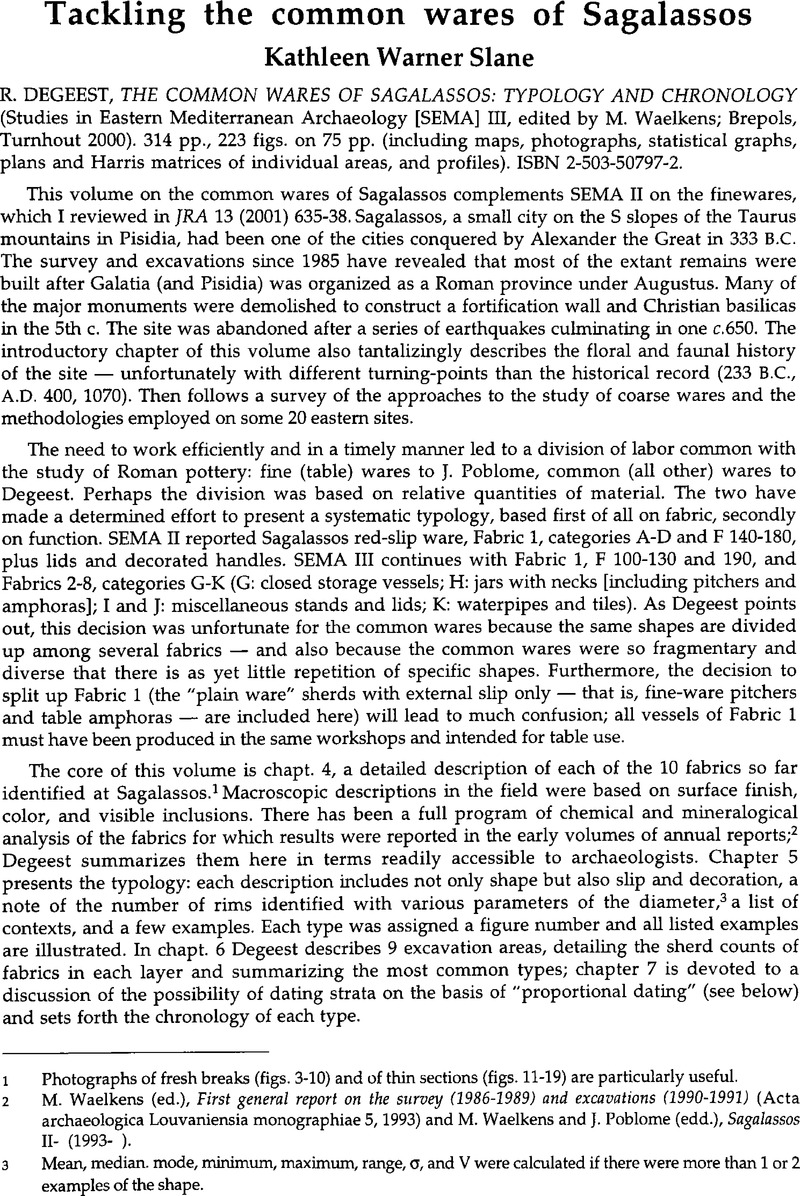No CrossRef data available.
Article contents
Tackling the common wares of Sagalassos - R. Degeest, THE COMMON WARES OF SAGALASSOS: TYPOLOGY AND CHRONOLOGY (Studies in Eastern Mediterranean Archaeology [SEMA] III, edited by M. Waelkens; Brepols, Turnhout 2000). 314 pp., 223 figs. on 75 pp. (including maps, photographs, statistical graphs, plans and Harris matrices of individual areas, and profiles). ISBN 2-503-50797-2.
Published online by Cambridge University Press: 16 February 2015
Abstract

- Type
- Reviews
- Information
- Copyright
- Copyright © Journal of Roman Archaeology L.L.C. 2002
References
1 Photographs of fresh breaks (figs. 3-10) and of thin sections (figs. 11-19) are particularly useful.
2 Waelkens, M. (ed.). First general report on the survey (1986-1989) and excavations (1990-1991) (Acta archaeologica Louvaniensia monographiae 5, 1993)Google Scholar and Waelkens, M. and Poblome, J. (edd.), Sagalassos II- (1993-)Google Scholar.
3 Mean, median, mode, minimum, maximum, range, σ, and V were calculated if there were more than 1 or 2 examples of the shape.
4 It is unfortunate that the sherds chosen for chemical analysis do not include any of the vessels catalogued here; further archaeological work will be hampered until either the samples are assigned to the typology or the type vessels are analyzed. Other infelicities which will haunt the project in future publications are the failure to define the clay and sherd clusters in the statistical analysis by the same numbers (51 unidentified samples of clay formed four clusters which correspond to four clusters of sherds, but sherd cluster 1 goes with clay cluster 4, sherd cluster 3 with clay cluster 2, and sherd cluster 4 with clay cluster 3; how much simpler if sherd cluster 1 went with clay cluster 1, etc.)! And some of the statistical analyses are meaningless; what is the point of a correlation matrix of clays and sherds (Appendix E) when the data-set includes at least four clay clusters and four sherd clusters?
5 Note that there are 39 samples of Fabric 4 here although only 38 are listed in Appendix C.
6 Degeest notes (85) that he was unable to subdivide Fabric 4 into sherds from cooking pots and those from jars-amphoras. I am reminded of the practice in Corinth from the 4th c. B.C. through at least the 4th A.D., that the “cooking-pot fabric” was also used to make pitchers, one-handled mugs, and a few other shapes which at Athens, for instance, were made of semi-glazed plain ware. Over the course of time several shapes which were originally “plain ware”, i.e., manufactured in the buff ware typical of Corinthian fine wares, came to be manufactured in “cooking fabric”. By the 6th c, Corinthian buff fine-ware fabric has essentially disappeared from the assemblages. Degeest's statement (84) that Fabric 4 replaced Fabric 1 plain ware by the mid-7th c. suggests a similar practice at Sagalassos (see p. 659). For Corinth, see my Corinth XVIII, ii. The Sanctuary of Demeter and Kore on Acrocorinth, Roman pottery and lamps (Princeton 1990)Google Scholar, esp. “Vessels for Cooking” and “Pitchers”, and “Tetrarchie recovery in Corinth: pottery, lamps, and other finds from the Peribolos of Apollo,” Hesperia 63 (1994) 127–56, esp. 149 Google Scholar. I have discussed the situation most thoroughly in “Corinth's Roman pottery: quantification and meaning,” Corinth XX (2002, forthcoming)Google Scholar.
7 In addition to waterpipes and multiple shapes of roof- and hypocaust tiles, it includes a loomweight, large basins, and at least 24 pithos lids; in fact, aside from stoppers (in Fabric 1) and cooking-pot lids (Fabric 4), almost all lids are of this fabric.
8 This consists of 5 handmade pithoi (5F) and 25 wheelmade pithoi all slipped on the rim and upper wall (5G).




